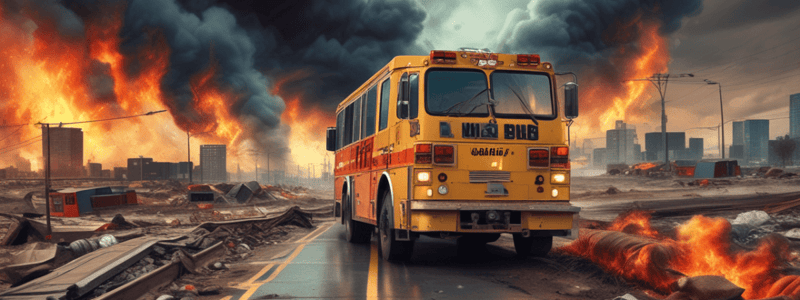Podcast
Questions and Answers
What is the primary purpose of the 3-deep deployment model?
What is the primary purpose of the 3-deep deployment model?
- To provide additional resources for crisis management
- To manage the strategic and tactical needs of the incident or sector (correct)
- To minimize the use of the greater alarm mechanism
- To prioritize incident action plans over firefighter rescue
What should the Incident Commander do if in doubt about calling for additional resources?
What should the Incident Commander do if in doubt about calling for additional resources?
- Request assistance in a piecemeal fashion
- Call for additional resources, as they can be put back in service if not needed (correct)
- Rely solely on crisis management strategies
- Wait and assess the situation further
What is the benefit of using the greater alarm mechanism?
What is the benefit of using the greater alarm mechanism?
- It is only used for crisis management situations
- It allows for piecemeal requests for assistance
- It is the quickest way to provide additional resources and support (correct)
- It provides a slower response rate to the incident
What is the purpose of sectorization in incident management?
What is the purpose of sectorization in incident management?
What is the primary risk of crisis management?
What is the primary risk of crisis management?
What is the 'Working' stage of the 3-deep deployment model?
What is the 'Working' stage of the 3-deep deployment model?
What is the purpose of having a tactical reserve of fire companies?
What is the purpose of having a tactical reserve of fire companies?
What is the primary responsibility of Command in a fire situation?
What is the primary responsibility of Command in a fire situation?
Why is it essential for Command to call for additional resources ahead of time?
Why is it essential for Command to call for additional resources ahead of time?
What is the result of not expanding the incident organization when calling for additional resources?
What is the result of not expanding the incident organization when calling for additional resources?
What situation may require the categorical call for additional alarms or upgrading an assignment?
What situation may require the categorical call for additional alarms or upgrading an assignment?
Why is it essential for Command to forecast the effect the fire will have on personnel?
Why is it essential for Command to forecast the effect the fire will have on personnel?
What happens when the commitment of companies is not effective?
What happens when the commitment of companies is not effective?
When should Command initiate some fire control activities?
When should Command initiate some fire control activities?
What is the consequence of not calling for additional resources ahead of time?
What is the consequence of not calling for additional resources ahead of time?
What should Command consider when determining the resources required?
What should Command consider when determining the resources required?
Flashcards are hidden until you start studying
Study Notes
Effective Emergency Incident Management
- The Incident Commander (IC) must balance tactical problems with the resources required to control them and stay ahead of the situation through effective forecasting.
Crisis Management
- Crisis management is a situation that grows at a rate faster than the response rate to that situation.
- It often leads to an out-of-control situation and inadequate resources to control it.
3 Deep Deployment Model
- The model provides for a tactical reserve of fire companies.
- Resources are deployed in support of the incident action plan.
- Resources are deployed in a 3-deep model:
- Working
- On-Deck
- Recycle/Staged
Additional Resources
- The greater alarm mechanism is the quickest way to provide automatic move-ups and support necessary for additional resources.
- Additional alarms should be struck sequentially (e.g., 3&1, 1st alarm, 2nd alarm, etc.).
- Command should resist requesting assistance in a piecemeal fashion.
- The early call for additional resources tends to save the day.
Situations Requiring Additional Resources
- Life hazard exceeds the rescue EMS capabilities of initial alarm companies.
- Number, location, and condition of actual victims exceed the rescue/removal/treatment capabilities of companies.
- Property protection demand exceeds the fire control capabilities of initial alarm companies.
- Fire conditions become more severe or the situation deteriorates significantly.
- All companies have been committed and the fire is not controlled.
- Command forecasts forces could be depleted due to exhaustion.
- Command anticipates running out of a resource (firefighters, apparatus, water, equipment, etc.).
- There is evidence of significant fire, but companies are unable to determine location and extent.
- The commitment of companies is not effective.
- Companies cannot effectively perform early loss control operations.
- The situation becomes so widespread/complex that Command can no longer effectively manage.
- The weather has or has the potential to have a particularly exhausting effect on resources.
- Command instinctively feels the need to summon additional resources.
Studying That Suits You
Use AI to generate personalized quizzes and flashcards to suit your learning preferences.



